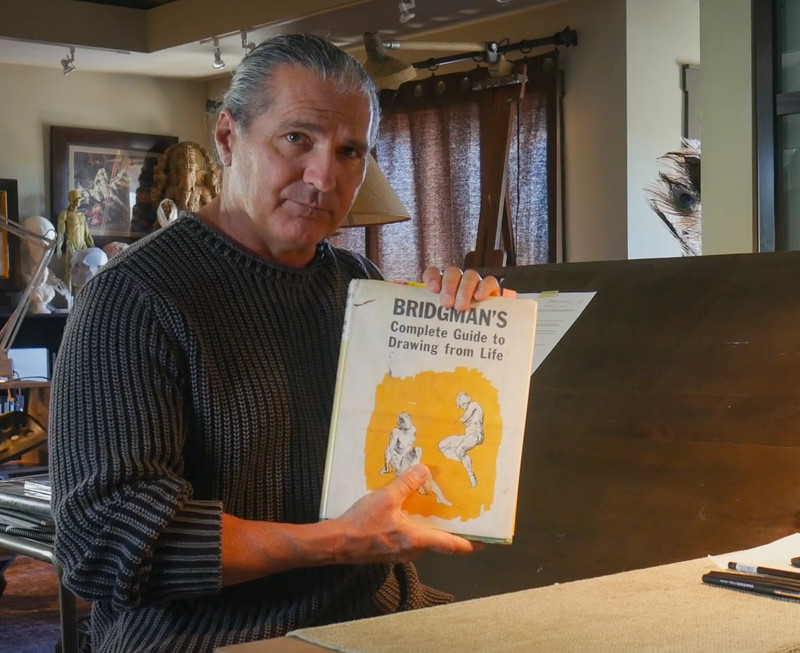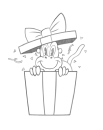The Bridgman Course
Watts on Bridgman
This course is all about studying from the great anatomist George Bridgman. His drawings are a fantastic breakdown of mass, weight, anatomy and design, but are often known to be messy. In this course we will learn how to understand his beautiful but chaotic drawings to grow ourselves as figurative artists.
The purpose of this course is threefold:
- To clarify the drawings of George Bridgman by drawing them cleaner. We need to make them easier to understand so we can pull out the pertinent artistic information.
- To apply Bridgman's concepts of expression and design to photos of a figure drawing model to deepen our understanding and learn how to use the information Bridgman teaches us in a real drawing scenario.
- To envision how we can take Bridgman's concepts and create our own invented figures. For this, we will break down and study the artwork of Frank Frazetta, whose figurative artwork exemplifies Bridgman's concepts in more fantastical form.
You'll often hear me describe this methodology throughout the course as Part what we see (real life observation/figure model), Part what we know (technical anatomy knowledge/Bridgman), and Part what we wish we saw (Frazetta/invention).
We will use three different drawing techniques:
- Charcoal on smooth newsprint
- Ballpoint pen on paper/sketchbook
- White pencils on black paper
These techniques will help you cross train and keep things fresh and interesting. The bulk of the drawings in this book will be done with the charcoal on newsprint. That is the main technique of my school, Watts Atelier. It's a cheap and efficient way to study. Follow my lead at first, but just because I'm doing a drawing in one medium doesn't mean that you have to do it the exact same way. Let your curiosity and interest lead you.
Summary
This course will use a three step learning method with three different drawing techniques. The purpose to is extract and apply the most important information from George Bridgman's drawings to become better figurative artists and take steps towards making our own fantastical figure drawings, designs, illustrations and paintings.
Join me for breaking down the drawings of Bridgman to understand how we can become exceptional figurative artists!
Required Materials
Books
To get the most out of this course, you'll need to make sure you have Bridgman's original book.
There have been many different versions of Bridgman's Complete Guide to Drawing from Life that have been made over the years. In Watts on Bridgman, I frequently reference page numbers from a specific version, so you need to make sure you have the right one. Just searching the title and buying the first book with that name will not work.
Here is the exact book that I reference all page numbers from:
Bridgman's Complete Guide to Drawing from Life: ISBN#0-517-25546-4
Drawing Materials
- Wolff's Carbon 6B Charcoal Pencils
- Smooth newsprint paper (recommended brands: Strathmore/Pacon/Seth Cole/Pro Art)
- Ballpoint pens
- Felt tip pens (Optional. Sakura Micron or equivalent recommended)
- Sketchbook/Loose leaf paper
- White colored pencils (different brands have different hardnesses, obtain a variety of
- brands)
- Black drawing paper or board
How this course is structured
I have laid out four distinct sections of anatomical study.
- Torso Front
- Torso Back
- Arms
- Legs
You can start with any of these sections, the exercises do not build upon each other in complexity from beginning to end of the course.
As mentioned, we will work between Bridgman, model photographs and studies from Frazetta. In the books and videos, you'll often see it laid out in an order as shown below.
- First we do a Bridgman Translation Drawing - Drawing and cleaning up Bridgman's drawing.
- Next we do a Photo Interpretation Drawing - Drawing from the model to apply Bridgman's concepts.
- Last we do a Frazetta Inspired Drawing - Studying Frazetta to understand how to use Bridgman in an artistic way.
Though I do recommend this approach, you can also first redraw all of Bridgman's drawings entirely in a section if you'd like, then proceed with photo and Frazetta studies. I would not suggest going right to the photo or Frazetta drawing exercises first. To get the most out of them you'll want to have the background knowledge from Bridgman first.
The videos in this course are organized by page number of their respective volume. Again, you don't have to work through the book in the exact order that it is laid out. Just follow the flow of whichever section you decide to start with. There is no "right" order when it comes to studying anatomy!
Full demos vs. drawing descriptions
There are two different types of videos in this course: The full drawing demonstrations and the supplemental drawing descriptions.
These videos serve different purposes. The full demos are meant for you to see the process, beginning to end, of each individual drawing. Throughout the course, there are about 30 hours worth of pure video demonstration.
I have included many drawings in the book that I did not record the step by step process of. I call these Practice Pages.
These Practice Pages have their own videos where I give a verbal explanation of the drawing on my iPad to provide additional insights. While these videos are not included in the main reel of demonstrations, they will be included as additional files in the package of downloads.
All videos in the course will be labeled by their page numbers, so do your best to follow along.
The first thing to do is copy all of Bridgman's drawings. Then we can try to apply his teachings to photos and invention/Frazetta study. Please refer back to the "How this course is structured" to fully understand why the drawings appear the order they do in the book, and how you'll want to follow along.
A great alternative is color copy paper and 6B or 8B graphite pencils sharpened to a taper. Make sure not to buy glossy photo paper. You can try to search for "color copy printer paper 28 lb"
You can refer to this video: Watts Atelier Pencil Sharpening
They are located in the downloads section as an additional zip file. You need to download and uncompress these files to view the videos.
In updating Volume I for e-book form and for future printing, we updated the page numbers and removed the QR codes from this version of the book and instead included all videos as downloads.
We also host all of the video demonstrations in this course on the Watts Atelier Online Program. In it's first iteration, Watts on Bridgman was only available in our Online Program, and our Online Program courses are listed in "Phases." We just didn't remove this wording from the intro title card of each video before offering it on Proko as well.
If you have any additional questions about this course, the best way to get quick answers from someone at Watts Atelier is to contact the following email address: support@wattsatelier.com



